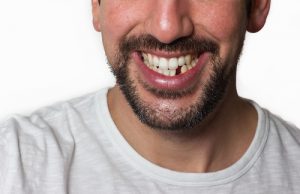As children, every person will sprout 20 primary teeth or baby teeth by the time they are 3 years old. These primary teeth hold a spot for the adult teeth to grow into as the baby teeth fall out. Once an adult, almost every person will have 32 permanent adult teeth. Many people will have lost at least one tooth for various reasons by the time they hit middle age, usually between 45 and 65 years old. A missing tooth can have serious consequences on the overall oral health of a person unwilling to correct the issue of a lost tooth.

Common Causes of Tooth Loss
In some cases, some people are simply born without the tooth, or maybe an adult tooth did not erupt to replace a baby tooth that fell out. Other times, a tooth is lost due to an accident. But most often, teeth are lost due to gum disease and decay. Untreated gum disease will cause inflammation and gums to recede. In more severe cases, the disease will attack the tissues and ligaments that support the tooth, such as the tooth roots and jawbone.
Effects of a Lost Tooth
Each tooth plays a vital role in the structure of the mouth. Leaving a gap in the teeth when a tooth is lost can disrupt the relationship between other teeth, which creates a negative result.
Ability to Speak
Depending on the placement of the lost tooth, speech can be greatly impacted. A person’s ability to articulate different sounds may be lacking with just one tooth missing.
Change in Bite
When one or more tooth is missing, the remaining teeth in the mouth begin to shift as the bite pressure is displaced when chewing or speaking. As the pressure on the teeth changes to compensate for the missing tooth or teeth, more weight is added to other areas of the mouth causing a shift over time. Sometimes, neighboring teeth will move into the place of the lost tooth.
Gum Disease
The gap left from a lost tooth welcomes plaque and other bacteria to become more easily accessible to the neighboring teeth. Without proper oral hygiene, the surrounding teeth and gums become susceptible to gum disease along with a host of other problems.
Appearance
Missing teeth, especially in the front of the mouth, that are visible when speaking in social environments can significantly affect a person’s willingness to smile and interact with others. Over time, a missing tooth can become an embarrassment and cause self-esteem issues.
Options for Replacing Lost Teeth
Dental Implants
This has become the most popular option when a tooth needs replacing. Dental implants are a permanent, long-lasting solution to a missing tooth. An implant looks and functions as other natural teeth do and does not need to be removed for cleaning like other options. The implant is a tiny titanium post that is placed into the bone socket of the missing tooth. The bone will grow around the implant, holding it firm. A new tooth is then fitted atop the post.
Fixed Bridges
A dental bridge is commonly used to replace several missing teeth in one area. A bridge consists of false teeth that are fixed to a frame and then attached to the neighboring teeth. Depending on the number of teeth missing, dental implants can be placed and the bridge frame can be attached to the implants instead of neighboring teeth.
Full or Partial Dentures
Dentures are a less popular option, especially for younger people. However, depending on the amount of teeth lost, dentures may be a more feasible option. While they do need to be removed for cleaning, proper fitting dentures will not impede a person’s ability to eat and speak normally.
If you are missing teeth and would like to set up a consultation to discuss options to best fit your needs, contact Dr. Kevin Sands by calling 310.273.0111.